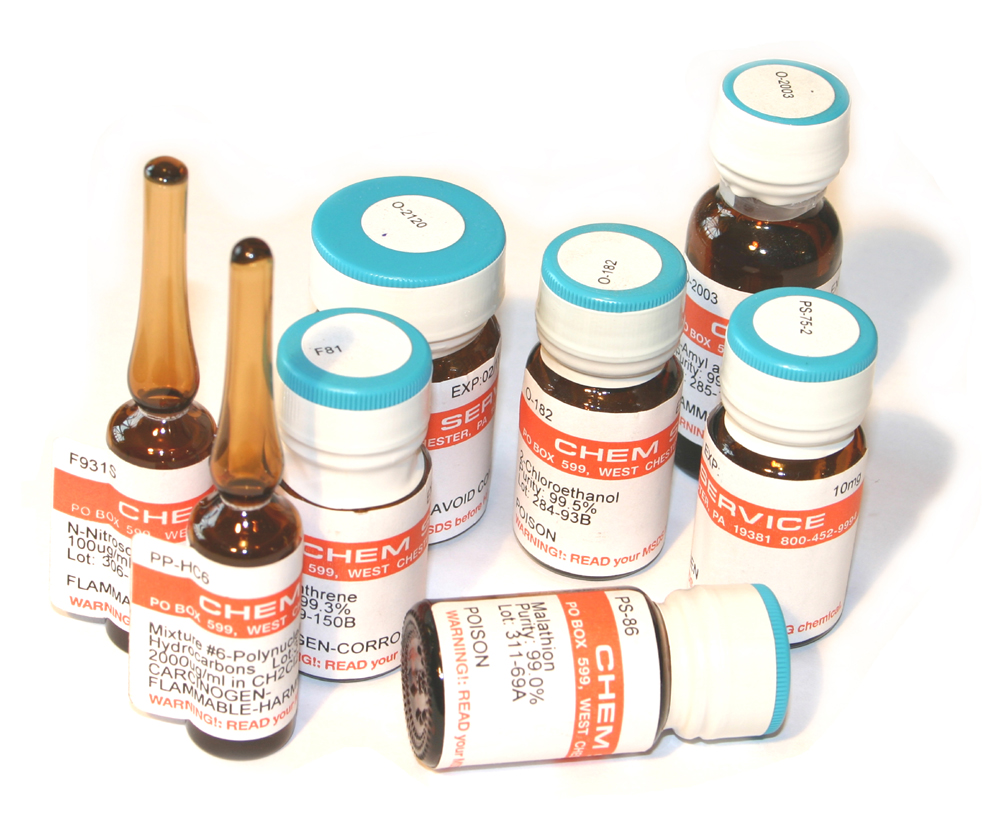Emamectin benzoate - N-12920-100mg

![]()
Emamectin benzoate Part No: N-12920 - 100mg
Emamectin benzoate is a naturally occurring soil Actinomycete and a macrycyclic lactone used against caterpillars mites, thrips and leaf miners as well as an Acaricide that is derived from emamectin. It was first introduced in 1997 in Israel and Japan then in the US by Syngenta Crop Protection, LLC in 1999. Currently registered by the EPA (PC Code 122806), California (DPR Code 04020) and for use in Australia, India, the Netherlands, New Zealand, South Africa and Vietnam. The current status under Reg. (EC) No 1107/2009 is pending.
Emamectin benzoate has been assigned CAS #155569-91-8, formerly 137512-74-4 and 179607-18-2.
Its formula is C56H81NO15 (emamectin B1a benzoate) + C55H79NO15 (emamectin B1b benzoate)
M.P. 141-146°C
What is it?
Emamectin benzoate is usually found as a mixture of two forms, which is a cream coloured powder. It is non corrosive and stable, except that it is flammable and may explode in the presence of strong oxidising agents. Emamectin benzoate melts at around 145 degrees celsius. It dissolves only slightly in water and seawater, but dissolves well in organic (carbon-containing) solvents.
What is it used for?
Emamectin benzoate is a pesticide which works by interfering with nerve impulses in the body. It is used in agricultural settings to control insects amongst vegetable crops such as cabbage and broccolli and on cotton plants - and in fish farms to control parasites such as sealice.
Where does it come from?
Releases of Emamectin benzoate occur as a result of its use as a pesticide. It might also be released during its manufacture, transport and storage. There are not thought to be any natural sources of Emamectin benzoate to the environment.
How might it affect the environment?
Emamectin benzoate is toxic to birds, mammals, fish and other aquatic organisms (particularly those living on the sea bed). Provided guidelines for safe use are followed, Emamectin benzoate should not harm wildlife or the environment. It is rapidly eliminated and excreted by fish and does not bioconcentrate in any organisms. Due to its low solubility in water, most releases will end up in sediments or particulate material. It is usually dispersed fairly efficiently, but is otherwise not particularly mobile. The amount of time taken for it to be broken down depends on the conditions (availability of oxygen, acidity), but it is usually removed within a few months. However, one of the main products of its breakdown is equally as toxic. Releases of Emamectin benzoate are only likely to have an impact on a local scale and are not thought to be of concern at a global level.
How might exposure to it affect human health?
Emamectin benzoate can enter the body either by inhalation of air containing emamectin benzoate, ingestion of contaminated food or water, or by dermal contact with emamectin benzoate. There is little evidence as to the full effects of exposure to emamectin benzoate on human health. However, exposure to emamectin benzoate may cause irritation of the respiratory tract, eyes and skin. Animal studies suggest that exposure to emamectin benzoate may also cause tremors. The International Agency for Research on Cancer has not designated emamectin benzoate in terms of its carcinogenicity. However, exposure to emamectin benzoate at normal background levels is unlikely to have any adverse effect on human health.
What steps are being taken to limit the potential impacts?
Releases of Emamectin benzoate are controlled through the Food and Environmental Protection Act (FEPA 1985), the Control of Pesticides Regulations (COPR 1986) and the UK Pollution, Prevention and Control (PPC) Regulations. It is also regulated through the European Directive concerned with levels of pesticide residues in foods (93/58/EC) - which in Scotland is implemented by the Maximum Levels in Crops, Foods and Feedstuffs regulations (MRL 2000).
Please see part number N-12920-100MG for current pricing
For 40 years Greyhound Chromatography has been supplying high quality Chromatography consumables to laboratories around the world. Greyhound’s extensive range covers all areas of Environmental, Petrochemical, Food, Forensics, Chemical and Pharmaceutical analysis. Backed by a highly experienced technical services team, Greyhound is the preferred source amongst today’s analysts.
Greyhound Chromatography is pleased to supply Chem Service Certified Reference Standards to Research and Analysis laboratories worldwide.
CONTACT US
Tel: +44 (0) 151 649 4000
Email: marketing@greyhoundchrom.com
FOLLOW US
YOU MAY ALSO BE INTERESTED IN OUR NEWSLETTER
About The Author
Susan Massie, Sales & Marketing Director, Greyhound Chromatography and Allied Chemicals Email: sue@greyhoundchrom.com
Susan Massie is the Sales & Marketing Director for Greyhound Chromatography and Allied Chemicals, affectionately known as 'Greyhound' in our scientific community. Greyhound was founded by Susan's husband Paul Massie almost 40 years ago, Susan hasn't been in the business for all of that time but has been involved with Greyhound for over 17 years. Greyhound continues to grow, expanding into new markets and taking on the challenges of our ever changing environment. It's heartwarming to witness the world waking up to the fact that we are damaging our planet on a daily basis. Every action we take has a direct effect on our planet and the world we leave behind for future generations. Susan is passionate about climate change and is happy to work in an industry that can have a direct effect on reducing the impact of our actions on the environment. All of the team at Greyhound take our responsibilities very seriously, the products that we supply are used by the world's leading scientists and chemists as they endeavour to monitor and repair the environment. All is not lost, if we all take responsibility for our actions, from reducing our waste and reusing or recycling our material collateral we can make a difference. The internet is full of useful advice and guidance, Susan is proud to contribute to that wealth of knowledge whenever she can.
Greyhound prides itself on personal service which provides prompt, efficient, cost-effective, safe delivery of all products. Greyhound provides technical advice and distribution of Certified Reference Standards and Materials, Laboratory Consumables, Solvents and Reagents across all scientific disciplines. Greyhound Chromatography offers over 1 Million products from its UK warehouse. The team at Greyhound are proud to support the work of the world's leading scientists and chemists as they challenge the abuse of our planet and try to make a difference to the world we leave behind for our ancestors.
You can view Susan's Linked In Profile here https://www.linkedin.com/in/susan-massie-79ab4121/
















